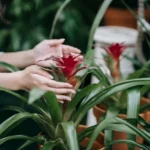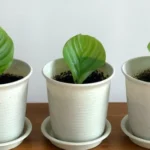Table of Contents
How To Care For Your Chinese Money Plant
The Chinese money plant – originally from china, makes the list of the top most popular homegrown plants. This plant is known for its decorative leaves shaped like pancakes but more like a coin.
This homegrown plant is also called the Pilea Peperomioides.
Anyone can grow the Pilea Peperomioides, so long as they are looking to add a greener, fresh, and beautiful look to their home. For this plant to grow well, it needs to be taken good care of, from good soils to perfect temperatures and water.
The following guide will help you know the right conditions to care for the Chinese money plant throughout its lifetime:
Light requirements
Good lighting is one of the essentials for the excellent health of the Chinese money plant. The Chinese money plant, though, is not friends with too much direct sunlight.
Too much light tends to give the leaves a purple hue appearance, so make sure to be careful with the amount of light around the Chinese money plant.
For example, a rapid increase in light causes burnt spots on the leaves of the Chinese money plant; therefore, it is good practice to move your plant gradually so it can get used to changing light conditions.
For perfect growth, always avoid areas with direct sunlight, especially in the afternoons.
Temperature requirements
Keeping the Chinese money plant outside is a good idea, but it is best to grow it indoors at room temperatures. The Chinese money plant won’t do well in temperatures lower than 10 degrees Celsius.
For this plant to grow well, it needs warmer temperatures than 10 degrees Celsius; therefore, you should avoid cold places and keep the plant from any risk of frost during the cold season.
Preferred Soil
The preferable soil for the Chinese money plant is soil that is slightly moist but not wet. Typically, when growing the Chinese money plant, you should consider using something like potting soil and perlite because of their excellent drainage.
Planting requirements
When planting the Chinese money plant, be ready to consider a pot that has drainage holes. This type of pot helps to prevent excess water, causing root rot.
Cheap options like a plastic nursery pot should work well for planting the Chinese money plant. Avoid pots that absorb moisture because they deprive the plant of enough water and cause the soil to dry.
Watering Pilea Peperomioides
The Chinese money plant likes to be thoroughly watered and then left alone to the point where the soil is almost dry before being watered again.
The idea of ‘leaving it alone’ does not mean abandoning the plant. Make sure you pay attention to the other requirements that facilitate the good health of the plant.
Remember, too much water may kill your plant. When watering the Chinese money plant, make sure to pay attention to the soil moisture.
Watering your plant twice a week during the summer season should work well. On the contrary, you should reduce the watering to once a week when winter rolls because the soil retains moisture for more extended periods during winter.
Humidity
Even though most locations will have a decent humidity level, the Chinese money plant will not thrive well in areas with excess humidity.
Avoid places like bathrooms and kitchens when growing the Chinese money plant. Extra humid, low light, and cool temperatures are all perfect ingredients to kill your plant. These conditions cause root rot problems and yellowing of the leaves.
Propagation
One appealing feature of the Chinese money plant is that it is easy to propagate. Sometimes,
when the Chinese money plant is appropriately taken care of, the propagation process occurs naturally by the plant producing baby plants on its stem and in the soil.
Once the baby plants have grown to 5-7cm in the soil around the mother plant, they can be separated by cutting and removing the continuous supply of baby plants with a clean, sharp knife.
You can grow the Chinese money plant direct from seed, but this is usually pretty difficult. Even though fresh seeds yield the best results, some seeds lose vigour fast.
It is always a gamble to buy seeds online because you do not know when the purchased seeds were collected.
Unless you have zero access to a mother plant where you can harvest seeds, growing the Chinese money plant from seed is not the best idea.
How to fertilize the Chinese money plant
The load of pups that are produced regularly need occasional feeding to keep everything working as desired. Make sure not to overdo it.
The Chinese money plant does not thrive well with a lot of fertilizer. The best way to fertilize your plant is by adding a little diluted regular houseplant or cacti based fertilizer at least once a month.
Do not use the fertilizer outside of the growing months. If the Chinese money plant is not nurturing new leaves, it is a sign that you should stop using fertilizer and flush its soil to remove excess fertilizer.
Repotting Pilea Peperomioides
The reality is that Pilea Peperomioides will eventually outgrow its pot and will need to be repotted.
This process usually happens because the mother plant produces so many baby plants that the pot is full. During the first year, repotting can be done twice, but only once a year after that.
When repotting your plant, make sure not to upsize it into a big container, but just one or two sizes up than your previous pot.
Common Problems: Causes And Cures
- The leaves are turning yellow
- The leaves are Falling Off
- The leaves are drooping
- The leaves are curling
Conclusion
If you follow the above tips correctly, growing and taking care of your Chinese money plant should not be challenging.
Remember, the plant grows fast when all the conditions are right, so it is your responsibility as the owner to pay attention to the little things that make the plant happy.
The Chinese money plant usually turns out to be a simple but unique gift for all occasion giveaways. This plant is easy to propagate, so you should have enough supply of gifts for your loved ones.
Pilea Peperomioides will eventually produce some flowers. The flowers are unremarkable but are still unique in their way.
Photo by Karolina Kot from Pexels



